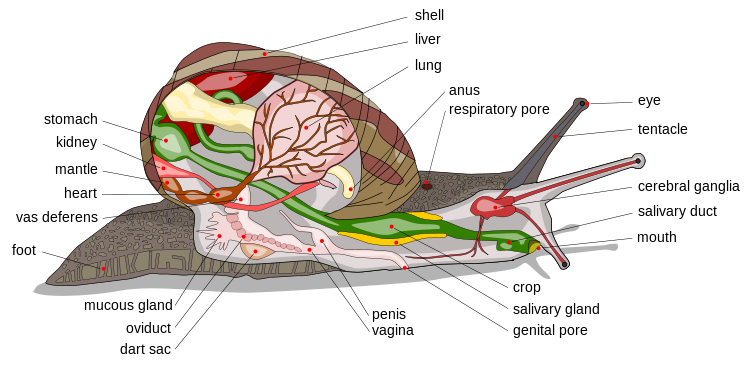Adaptation
Unfortunately, there is not a whole lot of information about the adaptations Stenotrema barbatum in particular. However, there is some material available about the suborder Stylommatophora. These terrestrial snails are known for their ability to breathe air through a vascular lung without gills, called the mantle cavity (Wilbur & Yonge, 1964). This is one of their adaptations to life on land. Land pulmonates breathe in two different ways, including through the opening of the breathing pore, called a pneumostome, and the constricting of the muscular foot (Wilbur & Yonge, 1966). The breathing rate of Stylommatophora is influenced by oxygen pressure, carbon dioxide, temperature, and level of humidity (Wilbur & Yonge, 1966).
Land snails are greatly affected by availability of water, as it is a major physiological problem for their survival (Wilbur & Yonge, 1964). Continual activity in snails is only feasible in locations where humidity is high, or else the snail risks drying out (Wilbur & Yonge, 1964). High humidity environments are therefore favored, but not 100 percent humidity due to risk of over-absorption (Wilbur & Yonge, 1964). Pulmonata combat water loss by having skin that is permeable to water, and when necessary they retreat into their shells (Wilbur & Yonge, 1964). Studies on partially submerged snails in water show elevated levels of water intake, showing that mucus also benefits water absorption (Fretter & Peake, 1975). When climates are too unfavorable, land snails either hibernate in the winter, or undergo dormancy in the summer (Fretter & Peake, 1975).
Stylommatophora have sensory adaptations, including four stalked antennae located on their heads, which are sensitive to chemoreceptors (Carnegie, 2005). The head and foot of these organisms also have touch receptors (Carnegie, 2005). The muscular foot also aids in locomotion (Wilbur & Yonge, 1964). The long foot has longitudinal muscles that undergo expansion and contraction to move the snail (Wilbur & Yonge, 1964). The shape of the foot also shifts to move the snail as its blood, or hemoskeleton, moves (Wilbur & Yonge, 1964). Finally, the foot also needs mucus to stick to surfaces on which the snail travels (Wilbur & Yonge, 1964).
Click here to learn the feeding habits and nutrition of Stenotrema barbatum.

